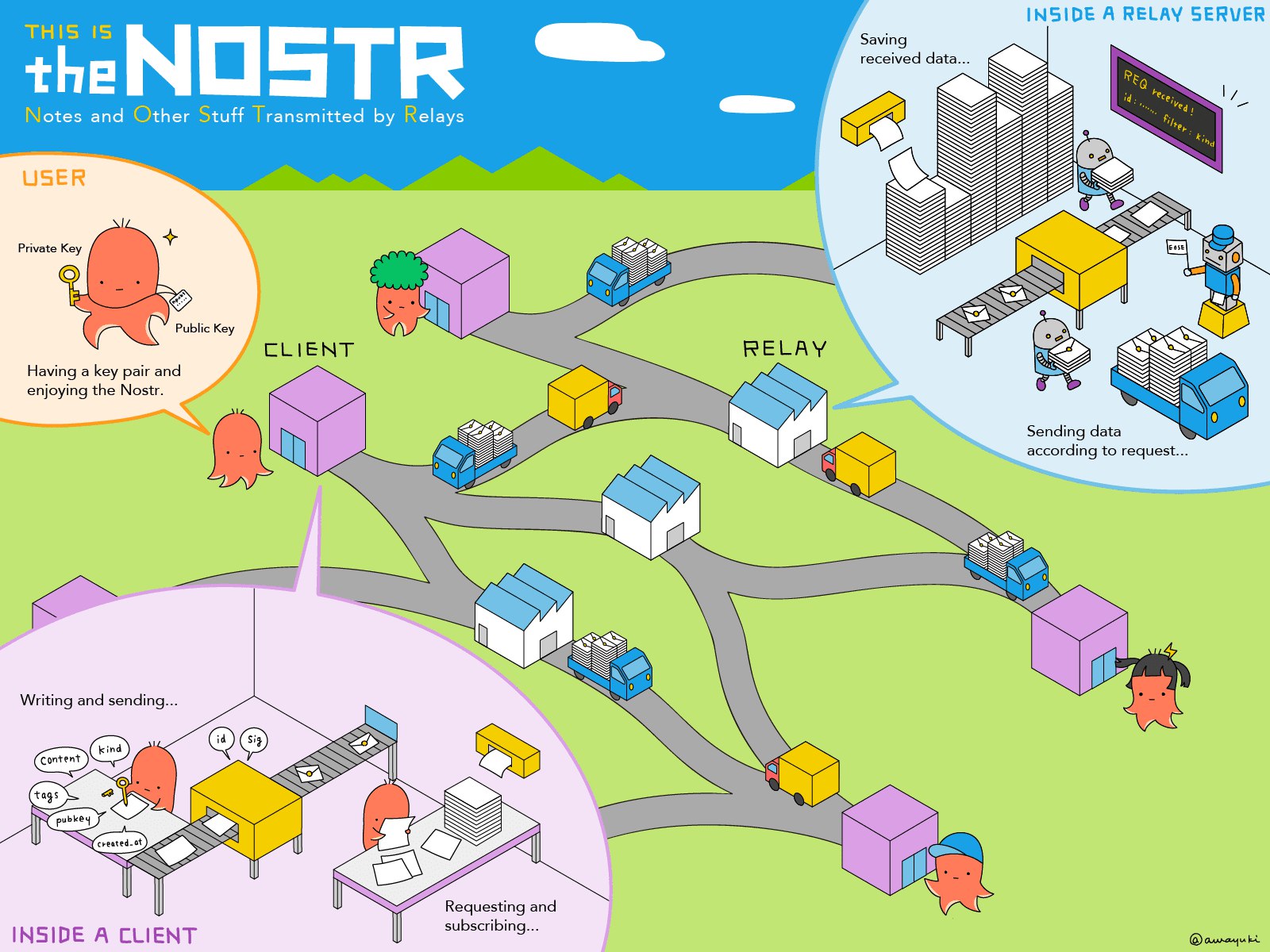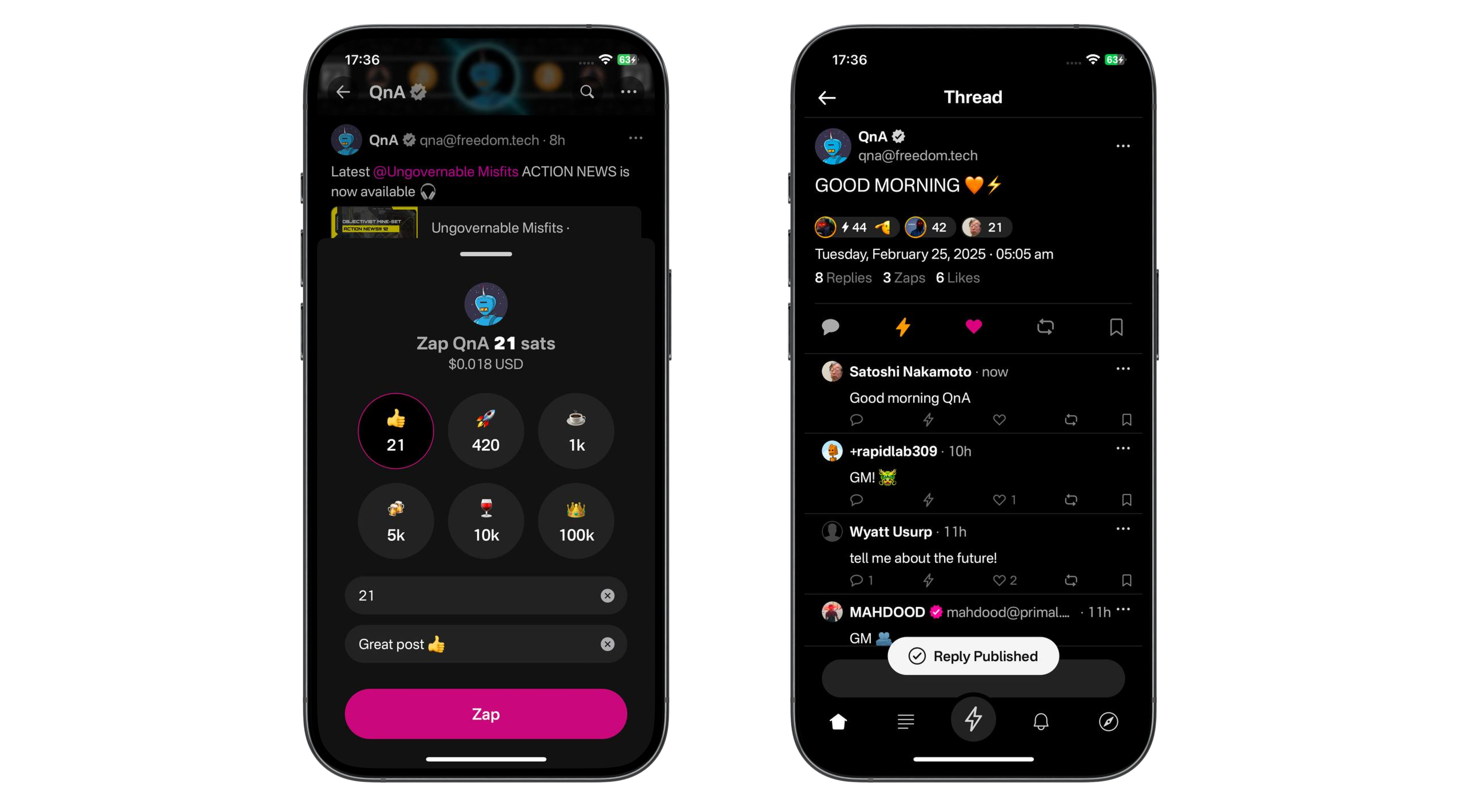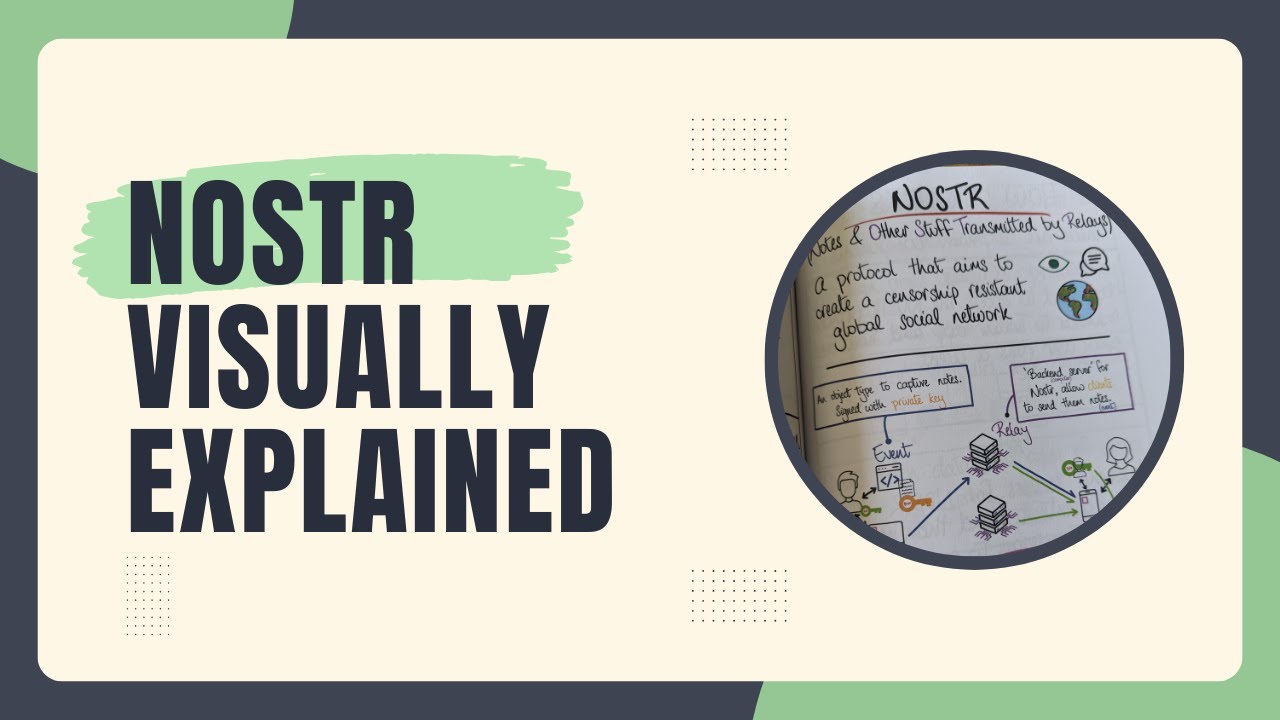At first glance Nostr might appear quite similar to some of the apps you use every day, such as Twitter, Mastodon, or Facebook, but that couldn’t be further from the truth. This post aims to dispel the myth that “Nostr is just a Twitter replacement” and give you a better understanding about the ‘what’, the ‘how’ and most importantly, the ‘why’ of Nostr.
What Is Nostr?
Nostr is a decentralized, open-source protocol designed for censorship-resistant networking and communication on the web. It stands for “Notes and Other Stuff Transmitted by Relays,” and it works by allowing users to publish messages (notes) and content in the form of ‘other stuff’, to a network of servers (relays) that store and distribute the content.
Unlike traditional platforms like Twitter, Ebay or Facebook, Nostr doesn’t rely on a central authority; instead, users control their own identities via cryptographic key pairs.
The simplest open protocol that is able to create a censorship-resistant global “social” network once and for all.
Fiatjaf - Nostr Creator
Nostr is not a website or an app you download from a single source — it’s an open protocol, like email or the internet. Think of it as a set of rules that anyone can use to build tools for sharing messages, posts, or other data without needing a centralized middleman like a big tech company.
Nostr was created by a developer named Fiatjaf in 2020, and has since been steadily gaining traction among people who care about privacy, freedom, and censorship resistance.

Why Nostr?
Imagine the scenario, you’ve been using an online platform for 5 or even 10 years. You’ve built up thousands of contacts, perhaps built yourself a sizeable reputation, or even rely on the income from the platform to feed your family. Then one day you make a controversial post, sell a certain item or upload a video on a spicy subject to the platform where the owner disagrees with. With the click of a button, your account is removed. All trace of you, your social graph, or even your future income, disappears in an instant.
Read aloud like that is sounds crazy that we’d even entertain using such a platform, right!? Sadly that is the reality in 2025. This is exactly what happens every single day on X, Facebook, Ebay, Paypal, Linkedin, etc.
Looking at the problem through a more social media focused lens, many of us have become slaves to the likes of Instagram, Twitter and TikTok. We use these ‘free’ apps under the guise of being social with others online. The reality is that we see what those apps want us to see. We’ve become slaves to the manipulation of complex and opaque algrorithms designed to keep us hooked and try to sell us things.

Unlike traditional platforms, which are often governed by centralized entities wielding significant control over user data, content moderation, and algorithmic influence, Nostr flips the script by prioritizing user sovereignty and resilience. Built on an open-source framework, Nostr allows individuals to control their own data and interact through a network of relays, making it much more difficult for any single authority — be it a corporation, government, or bad actor — to censor or manipulate the flow of information.
- Is a relay refusing to host your notes? Use another or run your own!
- A specific client using an algorithm you don’t like, take your identity and social graph elsewhere and choose another!
Take your identity and social graph with you, anywhere any time
QnA
Nostr’s ability to foster authentic, unfiltered conversations while safeguarding user sovereignty has made it a cornerstone for communities seeking alternatives—whether they’re activists, creators, or everyday people tired of being pawns in the data-driven game. It’s simple and adaptable design also encourages innovation, inviting developers to build tools and interfaces that keep pushing the boundaries of what the decentralized internet can achieve. In short, Nostr isn’t just a tool; it’s a movement toward a freer, more equitable digital future.

How Does Nostr Work?
Instead of one giant server owned by a single company holding all your posts and messages, Nostr spreads everything across lots of smaller servers called relays. To get started, you download a client, create your account and back up your private key. Your private key is used to secure your account and sign every message you send over the network. This allows anyone you interact with the verify the integrity of the data coming from ‘you’.
The Nostr network is essentially a collection of bulliten boards that share a common format
QnA
When you write a note, or share some other type of compatible data, your client signs it with your private key, then sends it to one or more relays. Which relays your information is sent to is entirely up to you. These relays share your message with others who want to see it.
For others to see your notes or ‘other stuff’, they’ll need to be able to find you. Typically this is done by using your public key, which looks something like this npub15c88nc8d44gsp4658dnfu5fahswzzu8gaxm5lkuwjud068swdqfspxssvx. Don’t panic though, you don’t need to memorize all of your friends public keys, there are more human friendly methods of finding people that we’ll come onto later.
Once someone is following you, their client will ask all of their connected relays for any data shared by your public key. Their client will receive this data, verify it is signed by your private key and then populate it into their feed.
 Nostr Explainer
Nostr Explainer
The “Other Stuff” Explained
Nostr’s name hints at this: Notes and Other Stuff Transmitted by Relays. But what is the “other stuff”? Put simply, it’s all the creative and experimental things people are building on Nostr, beyond simple text based notes. Every action on Nostr is an event — like a post, a profile update, or even a payment. The ‘Kind’ is what specifies the purpose of each event. Kinds are the building blocks of how information is categorized and processed on the network, and the most popular become part of higher lever specification guidelines known as Nostr Implementation Possibility - NIP. A NIP is a document that defines how something in Nostr should work, including the rules, standards, or features. NIPs define the type of ‘other stuff’ that be published and displayed by different styles of client for different purposes.
Here’s some content examples of ‘Other Stuff’:
- Long-Form Content: Think blog posts or articles. NIP-23.
- Private Messaging: Encrypted chats between users. NIP-04.
- Communities: Group chats or forums like Reddit. NIP-72
- Marketplaces: People listing stuff for sale, payable with zaps. NIP-15
- Zaps: Value transfer over the Lightning Network. NIP57
The beauty of Nostr is that it’s a flexible foundation. Developers can dream up new ideas and build them into clients, and the relays just keep humming along, passing the data around. It’s still early days, so expect the “other stuff” to grow wilder and weirder over time!
Clients vs. Relays: What’s the Difference?
Newbies often get tripped up by these two terms, so let’s clear define them.

Clients
A client is what you use to interact with Nostr. It’s the app or website where you type your posts, read your feed, follow and interact with others. Examples of Nostr clients include:
- Damus (iOS Twitter style client)
- Primal (Cross-platform Twitter style client)
- Amethyst (Android only Twitter style client)
- Habla.News (Web based blog client)
- Olas (Instagram style client)
- 0xchat (Messaging client)
Find 100s of other clients for all different types of use case here.
Clients don’t store your data; they just pull it from relays and display it for you. You can switch clients whenever you want, and your account stays the same because it’s tied to your keys, not any single client or app.
Clients are how you use Nostr, and relays are where the data lives. You need both to make the magic happen.
QnA
Relays
A relay is a server that stores and shares Nostr data. It’s a little like a post office: you send your note to a relay, and it delivers it to anyone who’s subscribed to see it (like your followers). Relays are run by individuals, groups, or companies who volunteer their computing power. Some are free, some charge a small fee, and you can connect to as many as you like. Most clients will come pre-configured with a list of well-known relays, but you can add or remove any you like.
What Are Zaps?
Zaps are arguably one of Nostr’s coolest features! A zaps is a way to send payments in Bitcoin directly to other users. Imagine liking a post, but instead of just clicking a heart (which you can of course do), you send the poster a few cents worth of Bitcoin to say, “This is awesome!”.
Zaps use Bitcoin’s Lightning Network, a faster and cheaper way to move Bitcoin around. To Zap someone, you need a Lightning wallet linked to your Nostr client. Some clients, like Primal, ship with their own custodial wallet to make getting started a breeze. Most clients also allow more advanced users to connect an existing Lightning Wallet to reduce reliance and trust in the client provider.
Zaps are optional but add a fun layer to Nostr. Creators love them because it’s a way to get direct support from fans, with no middleman required.
 Zapping in Primal
Zapping in Primal
NIP-05 Identifiers: Your Nostr “Username”
Your nPub, or public key (that long string of letters and numbers) is your ‘official’ Nostr ID, but it’s not exactly catchy. Enter NIP-05 identifiers, a human-readable and easily sharable way to have people find you. They look like an email address, like qna@hellonostr.xyz.
Here’s how it works:
Most users obtain their NIP-05 ID from a website or service that supports Nostr. Some of these services are free whereas some charge a fee. Some clients, like Primal will set one up for you automatically when you create an account.
The email like ID links to your public key, so people can find you more easily. And because these ID’s are domain based, there can be no duplicates. qna@hellonostr.xyz can only map to a single public key. The only person that can change that link is the person in control of the domain.
If you control your own domain, you can easily map your Nostr public key to name@my.domain. It’s not mandatory, but it’s super useful for building trust and making your profile recognizable.
Next Steps
So you’re bought in. You understand why Nostr is so important and want to get started. Check out our simple onboarding guide here.
Thanks For Reading
Hopefully that moistened your taste buds for more educational Nostr content. This was a basic one, but there will be more focused material coming soon.
If you found this post useful, please share it with your peers and consider following and zapping me on Nostr. If you write to me and let me know that you found me via this post, I’ll be sure to Zap you back! ⚡️





